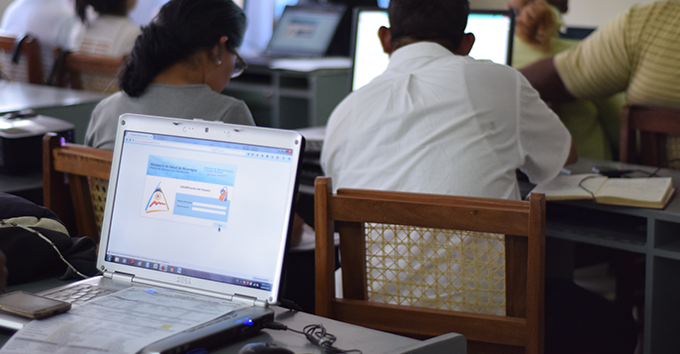SIVIPCAN: The Software which Helps Prevent Cancer
28/02/2018

The Movicancer Foundation, a Nicaraguan organization supported by LACNIC’s FRIDA program in 2014, has managed to go beyond its borders thanks to the SIVIPCAN system, a software which collaborates with cancer prevention.
Due to its extraordinary results, the program has been selected by the Network of National Cancer Institutes and Institutions of the Union of South American Nations (UNASUR) for its implementation in at least eight countries of the Southern Cone and four of Central America. UNASUR ministers regarded this Nicaraguan program as a reliable information system to monitor and assess the effectiveness of cancer prevention programs. SIVIPCAN will be adopted for cervical cancer control.
Orlando Martínez Granera, Vice President of Movicancer Foundation, believes that it is a “huge challenge” that requires great support and assured that, based on experience, the program has the “ability to implement a web system to standardize information in every country benefited by this project.”
What is the Surveillance System for Cancer Prevention in Women (SIVIPCAN) and how did the initiative arise?
Each year in Latin America more than 83,000 women are diagnosed with cervical cancer and almost 35,700 die for this reason.
All these deaths can be prevented and cured at low cost by healthcare services, even in the case of those with limited resources.
Why are so many women still losing the battle against this type of cancer? One reason lies in the way healthcare systems work to ensure their local programs are both efficient and effective.
In this sense, in 2007 the Nicaraguan Movicancer Foundation started an ambitious program that incorporates two innovative strategies. The first one was to develop a model that would allow gathering certain quality information necessary to assure the identification and monitoring of affected women. Said tool would allow to quickly evaluate whether a national, regional or local cervical cancer program was adequate, thus helping identify and correct defective interventions. As a result, a specialized software was designed and baptized as SIVIPCAN®, the Spanish acronym for Surveillance System for Cancer Prevention in Women.
This software collects the basic screening information, early diagnosis and treatment of each woman who receives services, according to her status on the way to healing.
The second strategy was to design a SIVIPCAN training program for doctors and nurses, with the aim of teaching them how to monitor and assess their own programs, interpret results and ensure that every identified woman received her complete treatment.
Has the program allowed to improve how to manage cancer control? Is there any evidence on how this tool has reduced the levels of such disease?
When the intervention started, the Ministry of Health gave us the opportunity to gradually work on this new program organization and management model. The American Cancer Society and Pan American Health Organization provided the funds to ensure this initiative was gradually implemented across the country. By the year 2012, more than 250 doctors, nurses and other staff were trained throughout the country.
Although during the first five years (2007-2012), there was an increase in the detection of new cases, since the year 2012 we were able to see the fruits of our efforts. In just four years (2012-2016 period), the impact of this type of cancer has decreased more than 24% and the Standardized Death Rate shifted from 26.1 to 14 in 100,000 women.
Have you managed to extend the platform and to make it available in all the regions of the country?
SIVIPCAN® is already implemented in Nicaragua and depending on regional Intranet or Internet access capabilities, its use is organized to work in a centralized (Intranet) or decentralized (Internet) manner.
What has been the experience of the program since receiving FRIDA support in 2014 for expanding and accelerating deployment of the SIVIPCAN software?
FRIDA support appeared at a critical moment because until that date, we only had three improved versions of SIVIPCAN®, all of them for desktop use.
Making SIVIPCAN® available online was our dream and FRIDA made this possible. After FRIDA’s intervention, the whole country was able to have this technology at local level.
SIVIPCAN has been selected for its implementation in at least eight countries of the Southern Cone and four countries of Central America. How did you take this news?
We feel very honored that the Network of National Cancer Institutes and Institutions (RINC-UNASUR) valued our effort and was willing to adopt a generic version of this software based on our experience. Developing this experience took us more than 10 years and, for the first time, Latin America has a Regional Information System for Cervical Cancer Control.
Which are the steps for its implementation at regional level? In which countries are you planning to start?
We are planning to start a pilot in one or two countries. Suriname has already offered to participate in the pilot program. Also, we are evaluating the possibility of working in Guatemala or Ecuador.
Are there any partners willing to support you in the development and implementation of the generic online version of SIVIPCAN?
At this moment we are looking for new partners. Developing this experience will cost between $300,000 and $500,000 dollars in a four year period.
We believe it will be necessary to work in phases on this project to ensure resources, as we advance in the development of this new experience that will save many lives and will unify national efforts to comply with the commitments agreed in the 55th meeting of the World Health Organization to reduce 25% of cancer mortality by the year 2025 and 33% by the year 2030, based on one of the United Nation Sustainable Development Goals.
(Free access, no subscription required)